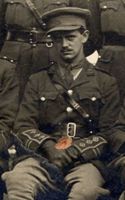
Photograph of Frederick in Tameside Local Studies and Archives Centre. Reference: MRP/4A/017

(L to R) Military Cross; British War Medal
Frederick was born on the 14th September 1892 in Stockport, Cheshire. His father was called Robert Henry and his mother was Lilian. He had an older brother called Robert Bertram and a younger sister called Ada Louisa.
Robert worked as a chemical manufacturer at the Prussiate Works in Droylsden, Manchester. In 1901 the family lived at 8 Grassmore in Higher Openshaw, Manchester. They employed a domestic servant named Ethel Cooke and a governess for the children called Mathilde Christine Munter.
Ten years later the family had moved to 442 Audenshaw Road in Audenshaw, near Droylsden. They no longer had any servants living with them. Robert had followed in his father's footsteps and begun to work as a clerk at a chemical works, but Frederick was moving in a different direction. He was a railway audit clerk.
The First World War broke out in August 1914 and Frederick joined the Army on the 13th January 1915. He still lived at 442 Audenshaw Road. He chose to join the 6th Battalion of the Manchester Regiment and was given the service number 3291.
When he enlisted Frederick was 5 feet 9 1/2 inches tall. He had 'good' vision and physical development. He joined the 3/6th Battalion, a training unit. On the 21st August he was promoted to Lance Corporal. He must have impressed his superiors because in mid October he was allowed to apply to be commissioned as an officer.
Frederick's application was approved and he became a Second Lieutenant on the 20th November. He joined the 27th (Reserve) Battalion in Southport, Lancashire. They moved to Altcar near Liverpool in May 1916.
Frederick was sent overseas on the 15th July 1916. He joined the 12th Battalion of the Manchester Regiment 5 days later. They were taking part in the Somme Offensive near Longueval at this time. In early August they were sent to Delville Wood, which had been the scene of extremely heavy fighting and had been reduced to what was described as a wasteland of shattered trees, mud and shell craters.
We don't know much about what Frederick did with the 12th Battalion, but we do know he was never posted to any other unit. They continued to fight on the Somme until the end of the Offensive in November 1916.
During the spring of 1917 the battalion took part in the Battle of Arras. On the 10th May Frederick was promoted to Acting Captain when he took command of a Company. In the autumn the battalion moved north to Belgium and fought around Ypres during the Passchendaele Offensive.
Back in the Somme area of France, the 12th Battalion took part in the desperate fighting aimed at stopping the German Spring Offensive of March and April 1918. By May the Spring Offensive had been defeated and the front line had stabilised.
In the London Gazette of the 26th July 1918 Frederick was awarded the Military Cross for bravery in action. This is his citation:
For conspicuous gallantry and devotion to duty when, his company being heavily attacked, he dealt with the situation with much coolness and skill, reconnoitring a sunken road, and ascertaining the exact position of the enemy, thus bringing his fire most effectively to bear.
We don't know exactly where or when this act took place, although it is likely to have been during the Spring Offensive.
The Allies began a counterattack on the 8th August that soon drove the Germans back. Although they were retreating the Germans still put up heavy resistance and the British lost many men attacking enemy positions.
On the 23rd August the 12th Battalion took part in an attack on Theipval Ridge. This position was strongly defended and the battalion took heavy casualties. They were not able to take the position and had to hold their ground for the next 3 days. The attack began again on the morning of the 26th, and soon succeeded.
Frederick did not take part in this advance. He was shot in the chest on the 25th August and evacuated for treatment. He was taken to the 51st Field Ambulance, but it was realised that his condition was serious and he was evacuated through Number 3 Casualty Clearing Station to Number 8 General Hospital in Rouen. He arrived here on the 28th, and a telegram was sent to his father at 59 Manchester Road.
Frederick's condition worsened. The telegram on the 28th had described him as 'seriously ill'. Another was sent the next day stating that he was now 'dangerously ill'. In the end Frederick's wounds were too serious and he died at 11am on the 5th September. He was 25 years old.
Robert was sent his son's personal effects later that month. These included Frederick's identity disc, a cheque book, a gold watch, a wallet, a knife, a gold ring, a cigarette case and 4 charms. Frederick must have worn dentures, because a set were returned to Robert. He also wore glasses, but the pair sent back to Robert were broken. Frederick's binoculars, prismatic compass and shaving set do not seem to have been found.
Frederick was buried in St Sever Cemetery in Rouen, alongside 3079 other men. He is buried in the Officers section of the cemetery, in grave C. 5. 3.
Lilian died in July 1931. We believe Robert Henry died in 1954. Louisa never married and died in Ulverston in the Lake District in 1966. She was 69. Robert Bertram was 95 when he died there in July 1985.
Frederick's medals were donated to the Museum of the Manchester Regiment in 1976. He was also awarded the Allied Victory Medal for his Army service.




